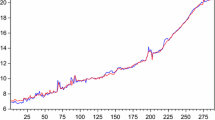Abstract
In investigating the causal relation between government revenue and spending, our empirical results support the tax-and-spend hypothesis for Egypt and the fiscal synchronization hypothesis for Jordan. Breaking away from these historical trends is essential for both countries to eliminate the budget deficit and therefore ensure the availability of domestic saving for private investment. To cope with unemployment and poverty, continuing privatization is recommended for both countries to improve productivity and efficiency in the domestic economy. Privatization should lead to higher domestic saving and investment and at the same time eliminate the budget deficit by enhancing revenue and curbing spending. (JEL H62, H63)
Similar content being viewed by others
References
Akaike, Hirotugu. 1969. “Fitting Autoregressive Models for Prediction.”Annals of the Institute of Statistical Mathematics 21: 243–247.
Baffes, John, and Anwar Shah. 1994. “Causality and Comovement between Taxes and Expenditures: Historical Evidence from Argentina, Brazil, and Mexico.”Journal of Development Economics 44: 311–331.
Baghestani, Hamid, and Robert McNown. 1992. “Forecasting the Federal Budget with Time-Series Models.”Journal of Forecasting 11: 127–139.
Baghestani, Hamid, and Robert McNown. 1994. “Do Revenues or Expenditures Respond to Budgetary Disequilibria?.”Southern Economic Journal 61: 311–322.
Barro, Robert J. 1974. “Are Government Bonds Net Wealth?.”Journal of Political Economy 82: 1095–1117.
Bohn, Henning. 1991. “Budget Balance through Revenue or Spending Adjustments? Some Historical Evidence for the United States.”Journal of Monetary Economics 27: 333–359.
Buchanan, James, and Richard Wagner. 1977.Democracy in Deficit. New York: Academic Press.
Buchanan, James, and Richard Wagner. 1978. “Dialogues Concerning Fiscal Religion.”Journal of Monetary Economics 4: 627–636.
Central Bank of Jordan. 2001. “Annual Report.” Online at: http://www.cbj.gov.jo.
Cheng, Benjamin S. 1999. “Causality between Taxes and Expenditures: Evidence from Latin American Countries.”Journal of Economics and Finance 23: 184–192.
Darrat, Ali. 1998. “Tax and Spend, or Spend and Tax? An Inquiry into the Turkish Budgetary Process.”Southern Economic Journal 64: 940–956.
Darrat, Ali. 2002. “Budget Balance through Spending cuts or Tax Adjustments?.”Contemporary Economic Policy 20: 221–233.
Engle, Robert F., and Clive W.J. Granger. 1987. “Cointegration and Error Correction: Representation Estimation and Testing.”Econometrica 55: 251–276.
Ewing, Bradley T., and James E. Payne. 1998. “Government Revenue-Expenditure Nexus: Evidence from Latin America.”Journal of Economic Development 23: 57–69.
Friedman, Milton. 1978. “The Limitations of Tax Limitation.”Policy Review: 7–14.
Granger, Clive W.J. 1969. “Investigating Causal Relation by Econometric Models and Cross-Spectral Methods.”Econometrica 37: 424–438.
Granger, Clive W.J. 1980. “Testing for Causality.”Journal of Economic Dynamic and Control 4: 161–194.
Hakkio, Craig S., and Mark Rush. 1991. “Cointegration: How Short Is the Long-Run?.”Journal of International Money and Finance 10: 571–581.
Hoover, Kevin D., and Steven M. Sheffrin. 1992. “Causation, Spending, and Taxes: Sand in the Sandbox or Tax Collector for the Welfare State?.”American Economic Review 82: 225–248.
Hsiao, Cheng. 1981. “Autoregressive Modeling and Money Income and Causality Detection.”Journal of Monetary Economics 7: 85–106.
Jordan Investment Board. 2000. “Investing in Jordan: Free Zones.” Online at: www.jordaninvestment.com.
Kimenyi, Mwangi S. 1990. “The Causal Relationship between Revenues and Expenditures: A Developing Country Case Study.”Journal of Public Finance and Public Choice 8: 3–11.
Lee, Jim. 1997. “Money, Income and Dynamic Lag Pattern.”Southern Economic Journal 64: 97–103.
Li, Xiaoming. 2001. “Government Revenue, Government Expenditure, and Temporal Causality: Evidence from China.”Applied Economics 33: 485–497.
Meltzer, Allen H., and Scott F. Richard. 1981. “A Rational Theory of the Size of Government.”Journal of Political Economy 89: 914–927.
Mithani, D.M., and Goh Soo Khoon. 1999. “Causality between Government Expenditure and Revenue in Malaysia: A Seasonal Cointegration Test.”ASEAN Economic Bulletin 16: 68–79.
Musgrave, Richard. 1966. “Principles of Budget Determination.” InPublic Finance: Selected Readings, edited by H. Cameron and W. Henderson. New York: Random House.
Payne, James E. 2003. “A Survey of the International Empirical Evidence on the Tax-Spend Debate.”Public Finance Review 31: 302–324.
Peacock, Alan, and Jack Wiseman. 1979. “Approaches to the Analysis of Government Expenditures Growth.”Public Finance Quarterly 7: 3–23.
Ram, R. 1988. “A Multicountry Perspective on Causality between Government Revenue and Government Expenditure.”Public Finance 43: 261–269.
The World Bank Group. 2001. “Egypt in Brief.” Online at: http://www.worldbank.org (October).
The World Bank Group. 2003. “Hashemite Kingdom of Jordan.”Jordan Quarterly Publication First Quarter: 7–14.
Wildavsky, Aaron. 1988.The New Politics of the Budgetary Process. Glenview, IL: Scott Foresman.
Author information
Authors and Affiliations
Corresponding author
Rights and permissions
About this article
Cite this article
AbuAl-Foul, B., Baghestani, H. The causal relation between government revenue and spending: Evidence from Egypt and Jordan. J Econ Finan 28, 260–269 (2004). https://doi.org/10.1007/BF02761616
Issue Date:
DOI: https://doi.org/10.1007/BF02761616




